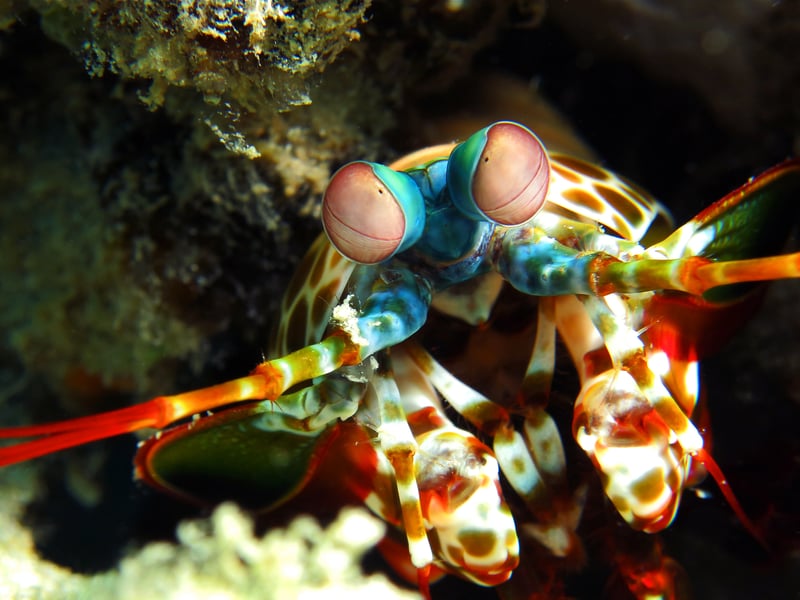The animal world is very rich in colors; animals live in a colorful world, but we rarely stop to reflect on how that color is produced and perceived, or how it has evolved.
This very interesting topic, and decidedly less obvious than one might suspect, attracted the attention of Innes C. Cuthill and collaborators, who in a beautiful (and colorful) article published in the prestigious “Science” magazine report the current situation on what is already known about the functions of color in animals, and the research the group intends to undertake to study how color is used as a form of communication between individual animals and how it affects interactions with parasites, predators and surrounding environment.
.jpg?width=800&name=Biology_colors_San_Raffaele_University%20(8).jpg)
The scientific study of colors
Given the complexity of the topic, it was necessary to involve experts from different fields, such as evolutionary biologists, behavioral ecologists, psychologists, optical physicists, visual physiologists, geneticists and anthropologists. In the last twenty years this field of research has expanded a lot, also thanks to technological advances - spectrophotometry, digital imaging, computational neuroscience, field studies and large-scale comparative analyzes - which will allow us to investigate this area with increasingly technical approaches.
.png?width=800&name=Biology_colors_San_Raffaele_University%20(2).png)
The iridescent throat of the broad-tailed hummingbird (Selasphorus platycercus) changes dramatically in appearance from black to magenta depending on the viewing angle and/or the angle of illumination.
From an adaptive point of view, color has been (and still is) anything but irrelevant: many of the “colored” functions of animals are in fact the surprising and ingenious result of multiple evolutive pressures, such that only those who possessed certain characteristics could be suitable for survival in that particular environment.
In the article (of which we will cite only a few passages below, in addition to other curiosities) it is concluded that animal coloring mediates the relationship between an organism and their environment in different ways, including social signaling between individuals, defense against predators, parasitic exploitation, thermoregulation, protection from ultraviolet light.

Specimen of "peacock mantis shrimp" (Odontodactylus scyllarus), crustacean of Indo-Pacific coral reefs. The presence of as many as 16 cones (the cells that allow us to see different colors), unlike the human being who only has 3, gives these creatures the ability to recognize different types of corals and fluorescent or almost transparent prey/predators.
Coloring to hide
That of “hiding” is one of the most fascinating (and vital) functions: confusing predators is essential to guarantee survival. For this reason, animals often camouflage themselves against a background of the same color, incorporating motifs and shades of the surrounding environment.
.jpg?width=800&name=Biology_colors_San_Raffaele_University%20(10).jpg)
The Australian green tree frog has a bright green color to blend in with the foliage; owls blend in with the trunk of the trees that host them.
.jpg?width=800&name=Biology_colors_San_Raffaele_University%20(11).jpg)
The reddish coat of the foxes allows them a perfect camouflage in the autumn woods. In the savannah, where intense light and yellowed meadows predominate, we find animals with a golden-ocher coat, such as lions and antelopes.
.jpg?width=800&name=Biology_colors_San_Raffaele_University%20(12).jpg)
.jpg?width=800&name=Biology_colors_San_Raffaele_University%20(13).jpg)
In areas that alternate snowy winter moments with periods of lush vegetation, it is useful to alternate as well a white coat for cold periods with a brown one for temperate ones, as does the ermine. Similarly, the color of the coat of the adult specimens of the white-tailed deer is reddish-brown in summer, and then turns to dull brown-brown in winter.
.jpg?width=800&name=Biology_colors_San_Raffaele_University%20(14).jpg)
On the glaciers, on the other hand, snow owls, bears and baby seals have white coats (a little curiosity: the hair of the polar bear is not white, but transparent. Each hair, devoid of color, contains an air pocket that reflects the light of the sun making them appear white; the skin, which is under the fur, is instead completely black, so as to absorb the incident light).
What about the animals that live in herds?
.jpg?width=800&name=Biology_colors_San_Raffaele_University%20(1).jpg)
.jpg?width=800&name=Biology_colors_San_Raffaele_University%20(2).jpg)
To hide its presence it is necessary to assume vertical streaks, as the zebra does, so that it is not possible to distinguish its outline from the other members. The streaks, on the other hand, become horizontal in the case of schools of fish such as the raccoon butterfly fish, whose black and yellow body makes it difficult for a predator to isolate a single individual within the group.
Coloring to alert
Yellow, red, orange, blue... there are so many bright colors that certain poisonous animals use to warn any predators about their toxicity. Some species, for example tropical frogs, make themselves visible by using their colors as warning signs and to be easily recognizable against the green and brown bottoms that characterize the environment.
.jpg?width=800&name=Biology_colors_San_Raffaele_University%20(3).jpg)
Coloring to mimic
The “danger alert” strategy is so effective that other absolutely harmless species imitate it by pretending a danger they do not represent. Some insects use this type of disguise: for example, some flies have the same yellow and black pattern on their backs as wasps; harmless snakes mimic the black and red striped pattern of the venomous coral snake, as does the Viceroy butterfly mimicking the venomous Monarch butterfly.
.jpg?width=800&name=Biology_colors_San_Raffaele_University%20(4).jpg)
.jpg?width=800&name=Biology_colors_San_Raffaele_University%20(5).jpg)
Coloring to romance
In many species, especially birds, the courtship ritual is based on the bright colors of the males, and on the showy and exhibitionistic ability to show them off.
.jpg?width=800&name=Biology_colors_San_Raffaele_University%20(6).jpg)
This is the case, for example, of the frigate, which inflates its flashy bright red jugular sac during courtship.
.jpg?width=800&name=Biology_colors_San_Raffaele_University%20(7).jpg)
The peacock, on the other hand, makes the famous “wheel”, flaunting its iridescent tail (which can accommodate up to 175 “eyes”) through complicated dances and movements. Females, on the other hand, prefer soft colors, to be able to brood and take care of their young in complete tranquility.
.png)

.jpg?width=800&name=Biology_colors_San_Raffaele_University%20(8).jpg)
.png?width=800&name=Biology_colors_San_Raffaele_University%20(2).png)

.jpg?width=800&name=Biology_colors_San_Raffaele_University%20(10).jpg)
.jpg?width=800&name=Biology_colors_San_Raffaele_University%20(11).jpg)
.jpg?width=800&name=Biology_colors_San_Raffaele_University%20(12).jpg)
.jpg?width=800&name=Biology_colors_San_Raffaele_University%20(13).jpg)
.jpg?width=800&name=Biology_colors_San_Raffaele_University%20(14).jpg)
.jpg?width=800&name=Biology_colors_San_Raffaele_University%20(1).jpg)
.jpg?width=800&name=Biology_colors_San_Raffaele_University%20(2).jpg)
.jpg?width=800&name=Biology_colors_San_Raffaele_University%20(3).jpg)
.jpg?width=800&name=Biology_colors_San_Raffaele_University%20(4).jpg)
.jpg?width=800&name=Biology_colors_San_Raffaele_University%20(5).jpg)
.jpg?width=800&name=Biology_colors_San_Raffaele_University%20(6).jpg)
.jpg?width=800&name=Biology_colors_San_Raffaele_University%20(7).jpg)